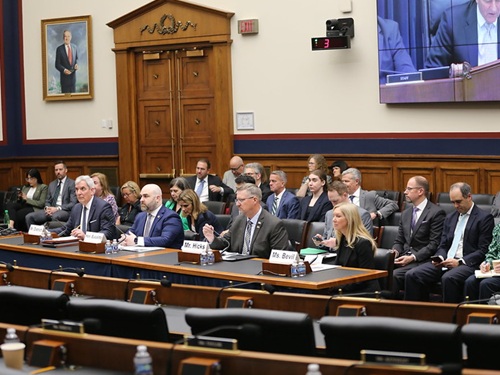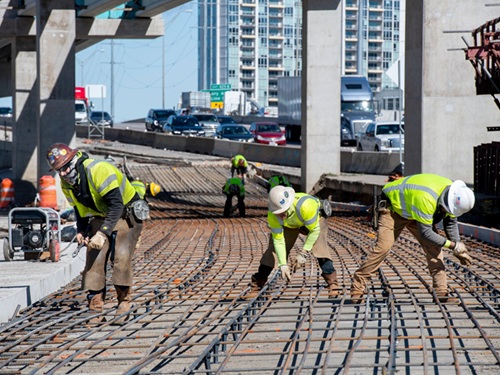A hearing held by the House of Representatives Transportation and Infrastructure Committee on May 6 explored ways to improve the “efficiency and effectiveness” of federal rail funding, both for passenger and freight service.
[Above photo by House T&I committee]
The hearing – held by the House T&I’s Subcommittee on Railroads, Pipelines, and Hazardous Materials – featured testimony from Garrett Eucalitto, commissioner of the Connecticut Department of Transportation and the 2024-2025 president of the American Association of State Highway and Transportation Officials; Matthew Dietrich, executive director of the Ohio Rail Development Commission (ORDC) and vice chair of AASHTO’s Council on Rail Transportation; Kevin Hicks, senior vice president of TranSystems on behalf of the National Railroad Construction and Maintenance Association; and Kristin Bevil, general counsel and chief legal officer of the Pinsly Railroad Company on behalf of the American Short Line and Regional Railroad Association.

“While delays to large projects garner all the media attention, many of the same laws, processes, and red tape that add years to project completion time and costs also plague smaller projects initiated by both freight and passenger [rail] service carriers,” noted Rep. Daniel Webster (R-FL), the subcommittee’s chairman, in his opening statement.
“Recognizing the importance of a safe, efficient, and reliable freight and passenger rail transportation system, Congress has authorized several programs to assist those carriers who, owing to their size or market segments, lack the resources of larger operators to invest substantial funds in their infrastructure,” he said. “Improving the efficiency and effectiveness of these programs is the purpose of today’s hearing and a goal as the [House T&I] committee works to reauthorize U.S. Department of Transportation surface transportation programs.”
“There are many communities across the United States that will benefit from sustained federal rail investments,” added Rep. Dina Titus (D-NV), ranking member on the subcommittee. “The Federal Railroad Administration has identified 69 corridors in 44 states as ready for additional investment. These corridors are in many of our districts, with proposed lines, extensions to existing routes or improvements to passenger rail service in 49 districts in this committee alone.”
Eucalitto noted in his testimony that rail serves as a “key component” of Connecticut DOT’s infrastructure and operations portfolio.

“With over 230 route miles of passenger rail, half of which is owned by Connecticut DOT, and 582 miles of freight rail, with 40 percent owned by Connecticut DOT, we invest heavily in railroad infrastructure to keep our economy moving,” he explained. “Just like our interstate highway system, our state’s rail system is a key component of the nation’s overall transportation infrastructure and economy, and we depend on a strong federal partnership.”
Eucalitto said that state departments of transportation continue to experience challenges with rail project delivery and permitting requirements – indeed, for the transportation infrastructure sector as a whole.
“Too often, these requirements can be duplicative and can unnecessarily delay the delivery of much-needed rail projects – with project costs escalating as a result,” he pointed out. “AASHTO members believe there are reasonable modifications to project delivery and permitting requirements that could more efficiently and effectively move rail projects forward without doing damage to the environment.”
For example, Eucalitto said that Congress should direct executive branch agencies to fully implement the One Federal Decision process to speed up the review timeline for projects and improve the accountability for all parties involved in a project’s development.
Congress should also take steps to modernize the use of the National Environmental Policy Act or NEPA – including by modifying the definition of a “major project” and “federal action,” he added
Additionally, with many large projects receiving funding from multiple federal partners, coordination amongst the various federal modal agencies should be improved, preferably with the agencies accepting their peer agencies’ environmental reviews and quickly designating a lead oversight agency/project sponsor, Eucalitto noted.
“These types of changes would better align federal resource agencies’ review and permitting actions that improve transportation and environmental outcomes while reducing delays,” he said.

ORDC’s Dietrich made a similar argument in his testimony, especially where “pre-qualifying” states to handle more direct project delivery responsibilities is concerned.
“Many states, including Ohio, have received authority from USDOT to assume the federal responsibilities regarding NEPA,” he explained. “In Ohio, we have NEPA assignment [responsibility] for both Federal Highway Administration and Federal Rail Administration programs. Expanding this program to encompass the administration of discretionary grants would reduce the burden on federal staff while simultaneously allowing states to more quickly advance awarded projects.”
By extension, Dietrich noted that since Ohio now has NEPA assignment responsibilities for FRA projects, programmatic agreements with resource agencies are being modified to include rail infrastructure projects.
As a result, he said ORDC – an independent commission within the Ohio Department of Transportation – is “updating our internal manuals and computer systems to process rail projects [which will] remove the uniqueness of administering FRA discretionary grants and allow us to use the standard project delivery processes that Ohio DOT uses to deliver its overall program of projects.”
Meanwhile, on the funding side, Eucalitto stressed that state DOTs continue to encounter challenges with the “consistency” of federal rail fiscal support and that they would benefit from measures to provide more consistent funding to enhance planning and project delivery efforts.

“Stable federal funding is essential to maintain the flow of anticipated investment in rail transportation improvements, maintenance, and operations; the absence of this stability leads to project delays that escalate costs,” he noted.
Eucalitto added that AASHTO has adopted an “overarching vision” for surface transportation reauthorization that covers state DOT work across the USDOT’s modal administrations – one that urges continued federal fiscal support on par with the Infrastructure Investment and Jobs Act or IIJA of 2021, including where freight and passenger rail needs are concerned.
“An overarching key success of the IIJA was the inclusion of a dedicated rail title with significant levels of authorized federal funding,” he explained. “These landmark funding levels have allowed state DOTs and railroads to actualize years of rail planning. The beneficial economic and social impacts of these investments highlight the need for continued federal support for rail program funding in the next surface transportation reauthorization bill.”



